Publications
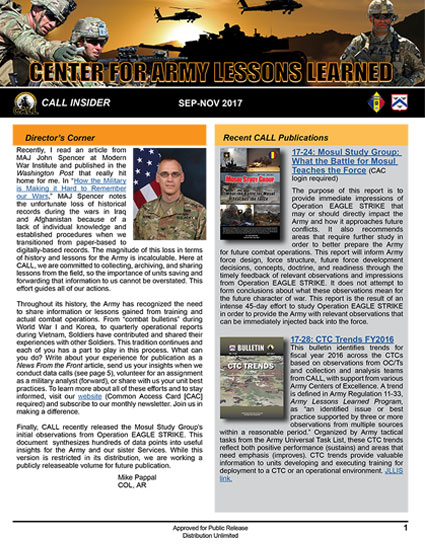 CALL Insider Newsletter SEP-NOV 2017
CALL Insider Newsletter SEP-NOV 2017
Recently, I read an article from
MAJ John Spencer at Modern
War Institute and published in the
Washington Post that really hit
home for me. In “How the Military
is Making it Hard to Remember
our Wars,” MAJ Spencer notes
the unfortunate loss of historical
records during the wars in Iraq
and Afghanistan because of a
lack of individual knowledge and
established procedures when we
transitioned from paper-based to
digitally-based records. The magnitude of this loss in terms
of history and lessons for the Army is incalculable. Here at
CALL, we are committed to collecting, archiving, and sharing
lessons from the field, so the importance of units saving and
forwarding that information to us cannot be overstated. This
effort guides all of our actions.
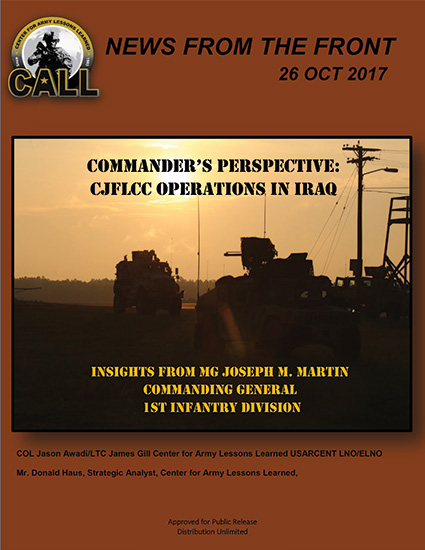 NFTF - Commander’s Perspective: CJFLCC Operations in Iraq Insights from MG Joseph M. Martin Commanding General
NFTF - Commander’s Perspective: CJFLCC Operations in Iraq Insights from MG Joseph M. Martin Commanding General
This News From the Front paper summarizes the key insights from an end of tour interview with MG Joseph Martin, Commanding General (CG), 1st Infantry Division and Combined Joint Force Land Component Command - Operation Inherent Resolve (CJFLCC?OIR). The interview, conducted at the conclusion of his tour, in Iraq on July 12, 2017, contained focus areas that capture best practices and lessons learned during his tenure as the CG.
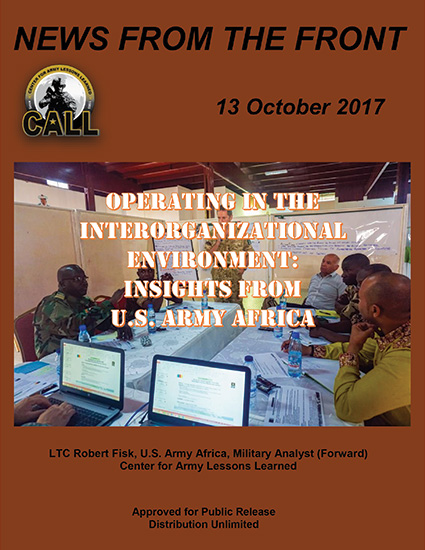 NFTF - Operating in the Interorganizational Environment: Insights from U.S. Army Africa
NFTF - Operating in the Interorganizational Environment: Insights from U.S. Army Africa
U.S. military leaders and planners must understand the purpose and mission of the many governmental, nongovernmental (NGO) and international organizations in the area of operations to facilitate collective cooperation. This paper highlights some challenges the U.S. Army faces when operating in the interorganizational environment and provides insights to enhance collaboration to achieve mutual objectives. These insights were collected during the civilian-led Interorganizational Tabletop Exercise (ITX) conducted in Washington D.C., hosted by the U.S. Institute for Peace (USIP) in conjunction with the Department of Defense (DOD), and the Joint Staff J-7 Exercise Directorate from 17 ? 20 July 2017.
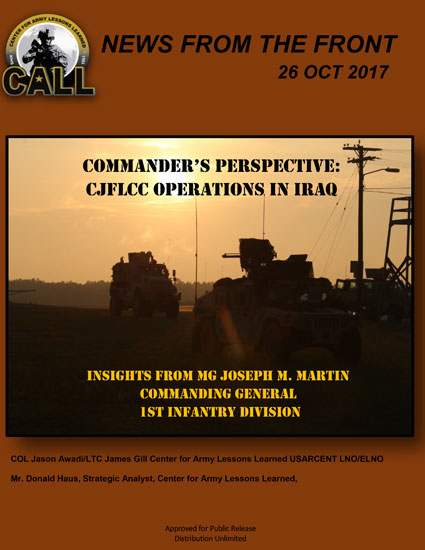 News From the Front - Commander's Perspective: CJFLCC Operations in Iraq
News From the Front - Commander's Perspective: CJFLCC Operations in Iraq
This News From the Front paper summarizes the key insights from an end of tour interview with MG Joseph Martin, Commanding General (CG), 1st Infantry Division and Combined Joint Force Land Component Command - Operation Inherent Resolve (CJFLCC–OIR). The interview, conducted at the conclusion of his tour, in Iraq on July 12, 2017, contained focus areas that capture best practices and lessons learned during his tenure as the CG.
The interview questions highlighted but were not limited to:
• Force protection
• By, with, and through environment
• Deployment of forces
• Tactical Directive #1
• Targeting
• Training
• Intelligence
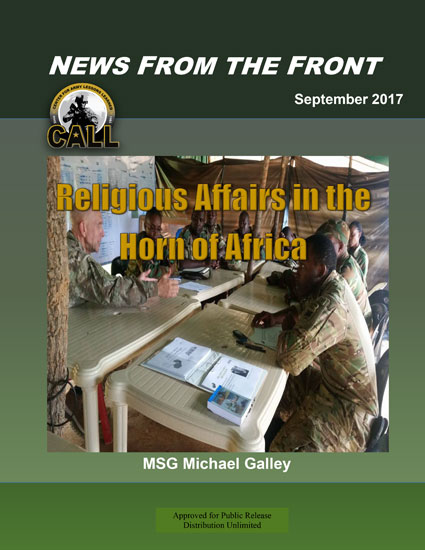 NFTF: Religious Affairs in the Horn of Africa
NFTF: Religious Affairs in the Horn of Africa
U.S. Armed Forces chaplaincies support various joint operations in order to accommodate religious needs, provide religious and pastoral care, and also advise commanders on the complexities of religion with regard to personnel and mission, as appropriate. Religious affairs in joint military operations play a vital role in supporting commanders throughout the operational area, in alignment with the commander's overall theater security program. Religious affairs is not often used by commanders as a "first choice multiplier" during military engagements with our friends and allies; however, it can be effective in building relationships for the long term. This news from the front (NFTF) article discusses a program known as Voices of Religious Tolerance (VORT) which was employed in Afghanistan, Jordan, and Somalia, and provides a way to involve religious affairs to support countering extremist ideas. This NFTF should be useful to religious affairs teams attempting to use this program or build a similar one.
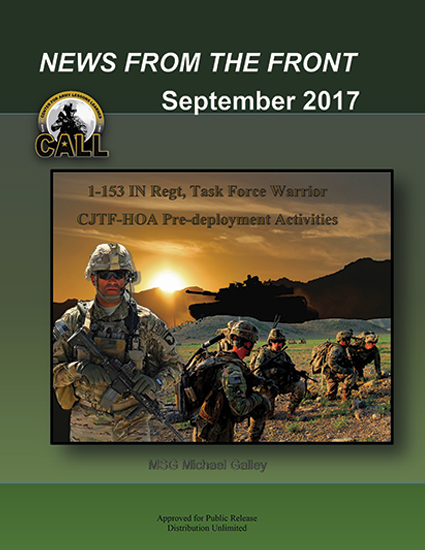 NFTF - 1-153 IN Regt, Task Force Warrior CJTF-HOA Pre-deployment Activities
NFTF - 1-153 IN Regt, Task Force Warrior CJTF-HOA Pre-deployment Activities
The Army Reserve and National Guard participation with the active component providing support for theater security operations and exercise both CONUS and OCONUS has increased drastically over the past 15 years. Army Reserve and National Guard units are given the maximum time possible between the date alerted and the date required to report for active duty. Some units may be alerted, but not actually begin active duty for several weeks. However, under mobilization conditions, an emergency situation may require extremely short active duty notice. This news from the front (NFTF) provides insights into one National Guard battalions mobilization process as it prepared to deploy to the Horn of Africa.
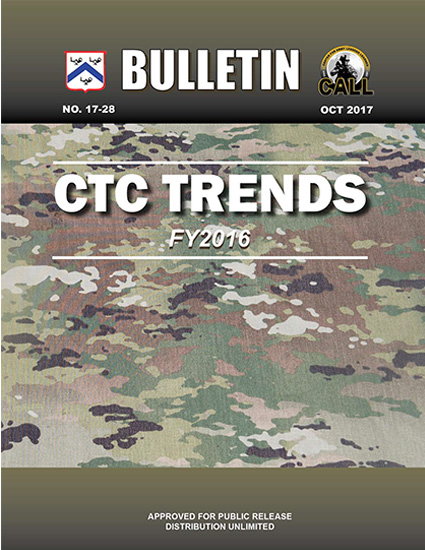 17-28 - CTC Trends FY16 Bulletin
17-28 - CTC Trends FY16 Bulletin
This CTC Trends Bulletin identifies trends for fiscal year 2016 across the CTCs, based on observations from observer–coach/trainers (OC/Ts) and collection and analysis teams from the Center for Army Lessons Learned (CALL), with support from various Army Centers of Excellence. A trend is defined in Army Regulation 11-33, Army Lessons Learned Program (14 JUN 2017), as “an identified issue or best practice supported by three or more observations from multiple sources within a reasonable period.” CALL collects observations, best practices, and training results from OC/Ts at the CTCs; analyzes them; and compiles them annually in a publication. Organized by Army tactical tasks from the Army Universal Task List, these CTC trends reflect both positive performance (sustains) and areas that need emphasis (improves). CTC trends provide valuable information to units developing and executing training for deployment to a CTC or an operational environment. Each chapter includes recommendations for units to successfully execute identified tasks. This provides a reference for training emphasis at home station. Additionally, identifying and analyzing trends allow doctrine writers, training developers, and other Army problem solvers to receive successful techniques and identify gaps in capability for doctrine, organization, training, materiel, leadership and education, and personnel and facilities (DOTMLPF) solutions. Applying the lessons learned at the unit or the institutional level from trends that are identified enables the Army to be a continually learning organization.
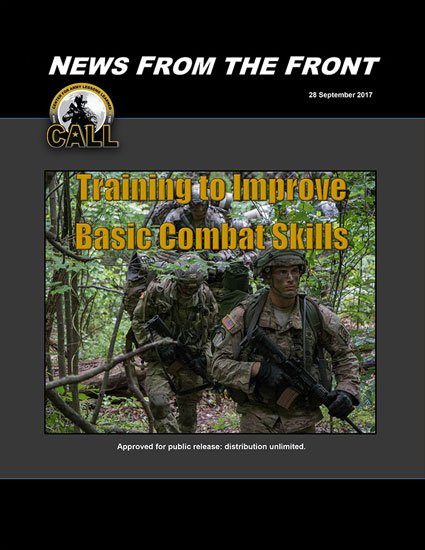 NFTF: Training to Improve Basic Combat Skills
NFTF: Training to Improve Basic Combat Skills
The purpose of this article is to illustrate how ROTC Cadet Command approached improving basic combat skills and fieldcraft through command emphasis, mission command, and the eight-step training model. While Cadet Command’s efforts are what inspired this document, the lessons and best practices are applicable for training programs for most junior Army leaders. This Center for Army Lessons Learned (CALL) document was produced with the cooperation and input of ROTC Cadet Command and ROTC Advanced Camp cadre and staff.
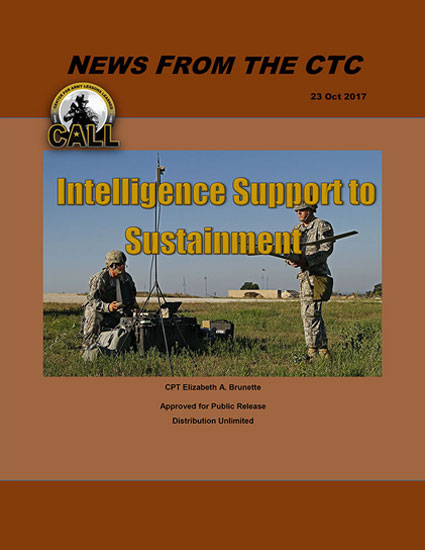 News from the CTC: Intelligence Support to Sustainment
News from the CTC: Intelligence Support to Sustainment
Today’s Army Logisticians rely on a robust intelligence enterprise to provide timely and accurate information to deter threats and minimize interruptions to sustainment operations. Within combat sustainment support battalions (CSSBs), the intelligence cell is required to provide intelligence information to support current and future operations and plans. The Army’s active duty and reserve CSSBs test this support requirement regularly at the combat training centers (CTCs).
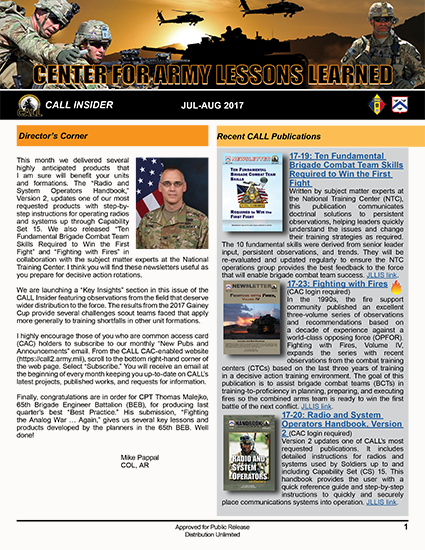 CALL Insider Newsletter Jul-Aug 2017
CALL Insider Newsletter Jul-Aug 2017
This month we delivered several highly anticipated products that I am sure will benefit your units and formations. The “Radio and System Operators Handbook,” Version 2, updates one of our most requested products with step-bystep instructions for operating radios and systems up through Capability Set 15. We also released “Ten Fundamental Brigade Combat Team Skills Required to Win the First Fight” and “Fighting with Fires” in collaboration with the subject matter experts at the National Training Center. I think you will find these Newsletters useful as you prepare for decisive action rotations.
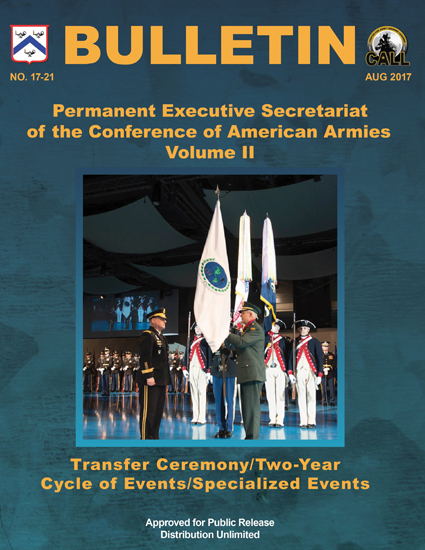 17-21 Permanent Executive Secretariat of the Conference of American Armies Vol II Bulletin
17-21 Permanent Executive Secretariat of the Conference of American Armies Vol II Bulletin
The CAA conducts a two-year cycle of specialized conferences/exercises hosted by different member armies. Each cycle ends in a preparatory meeting that reviews the accomplishments of the previous two-year cycle and approves the agenda for the forthcoming conference and Commander's Conference of the American Armies (CCAA). The CCAA is conducted by the army hosting the Permanent Executive Secretariat CAA (or PESCAA) for that particular cycle. Hosting of the PESCAA voluntarily rotates every two years. The host nation serves as the CAA headquarters responsible for coordinating all current cycle CAA activities in addition to hosting the preparatory meeting and commander?s conference. This bulletin contains valuable information to inform leaders from all conference member nations on the goals, processes, and procedures as a contributing army and prepares them to assume the critical role of leading the PESCAA in the future. This publication is the second volume, in a series of three, produced for the CAA. It is a ?how to? guide outlining the structure and operation of the two-year cycle of events, culminating in the transfer ceremony of the CAA cycle.
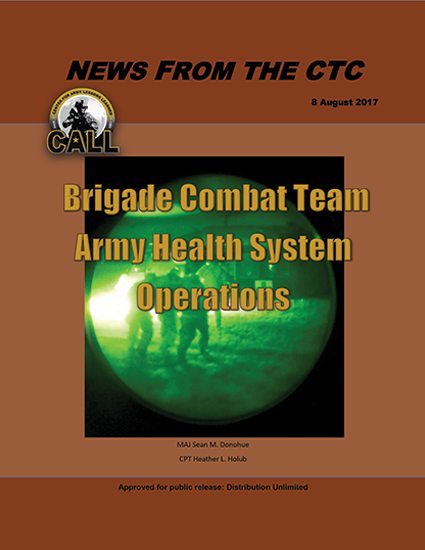 News from the CTC Brigade Combat Team Army Health System Operations
News from the CTC Brigade Combat Team Army Health System Operations
News From The CTC written by NTC Medical Observer Controllers. This article discusses medical best practices at the Battalion and Brigade level. Useful for medical professionals, planners and sustainment personnel involved with medical operations.

